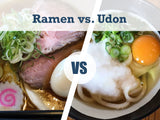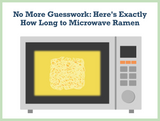
Ramen noodles are a type of Japanese noodle made from wheat flour and typically served in a flavorful broth.
They are long, thin, and have a slightly chewy texture.
Ramen noodles are a staple in Japanese cuisine and are enjoyed by people all around the world.
They can be served hot or cold, and are often accompanied by a variety of toppings such as sliced meats, vegetables, eggs, and green onions.
These noodles are in a bowl of ramen, tsukemen, and hiyashi chuka.
Want to know more about the noodles?

1. There are raw ramen noodles and dried ramen noodles
The biggest difference between these two kinds of ramen noodles are…
Texture, storage stability and boiling time.

1. Raw ramen noodles have a bouncier texture.
Almost all the ramen shops use these raw ramen noodles.
Raw noodles take a very short time to boil.
However, its storage time is very short and you must store raw ramen noodles in the fridge.
Raw noodles last less than 2 weeks.

2. Dried ramen noodles have a softer texture.
Dried ramen noodles are usually for homecooks.
They don’t consist of water.
So you can store dried ramen noodles for a long time at room temperature.
Dried ramen noodles can last for more than half a year after the production.
3. Dried ramen noodles have 2 kinds depending on how they are dried
One is deep fried noodles.
They are the most common in instant ramen noodles.
And the other is non-fried ramen noodles.
They are made in an air dry machine.
It is healthier because non-fried noodles contain less oil.
And the taste is between raw noodles and deep fried noodles.
Popular products of non-dried noodles are Maruchan Seimen and Nissin Raoh.

2. Ramen noodles are made of...
Kansui, flour, and water.
Raw ramen noodles and instant ramen noodles are both made of these 3 ingredients.

1. Kansui
Kansui is an alkaline solution (usually sodium carbonate or potassium carbonate).
Kansui makes noodles...
Yellow,
Chewy, and
Gives it its distinct ramen noodle flavor.

2. Wheat flour
Flour that is used for ramen noodles contains the amount of protein between all-purpose flour and bread flour.
It contains 11 to 13 percent of protein.
At some ramen restaurants, chefs mix cake flour and bread flour in order to make ramen noodles.
If you want to make flour that way...
The ratio should be 1 portion of cake flour to 3 portions of bread flour.

3. Water
Amount of water you mix with flour is also very important.
Regular ramen noodles contain 30 to 35 percent of water.
Low water addition rate noodles are under 30 percent,
Important:
Less water makes the ramen noodles denser.
By contrast,
High water addition rate of noodles is over 35 percent.
Note:
High water percentage makes the noodles chewer.
Water addition rate is calculated this way…
Example:
You use 1000 grams of flour and 300 grams of water to make ramen noodles.
That means the water addition of the noodles is 30 percent.

3. All ramen noodles are not the same
Ramen noodles have a variety of thickness and shapes.
It is usually decided by ramen types.
For example...
Shoyu ramen goes well with straight, medium-thick, and low water addition noodles.
Tonkotsu ramen goes well with straight and very thin, and low water addition noodles.
Miso ramen goes well with yellow, wavy, medium-thick and high water addition noodles.
Shio ramen goes well with straight, thin to medium-thick, and high water addition noodles.
It also depends on the ramen restaurant!

4. Do you want to know how ramen noodles are different from other noodles?
If ramen noodles have relatives...

1. Instant noodles are siblings.
Raw ramen noodles and instant noodles are made of the same ingredients.
The only difference is instant noodles are deep fried or air dried.

2. Udon noodles are your cousin.
Udon and ramen noodles are both made of wheat flour.
They are both Japanese cuisines.
And they are both in a soup.
That makes udon and ramen similar.
The difference is udon noodles have white color and ramen noodles have a yellowish color.
And udon noodles are way thicker than ramen noodles.

3. Pasta is a second cousin.
Pasta and ramen noodles are both made of wheat flour too.
But the difference is, pasta is made of unleavened durum wheat flour, water, and eggs
Another difference is pasta is dence, and ramen is chewy.

4. Soba is a distant relative.
Soba is made of soba flour.
They have similar shapes and thickness.
Soba influenced ramen a lot.
Do you know the reason why ramen has nori as a topping?
Because nori was a topping of soba.
A lot of soba chefs turned into ramen chefs after ramen gained popularity.

5. Pho is a distant relative.
Pho noodles are made of rice powder.
Pho noodles are translucent and soft compared to ramen noodles.

5. Due to Covid, a lot of good ramen restaurants have closed
It makes me feel very sad.
I used to eat ramen out frequently,
But in this situation,
Ramen shops started to shorten the hours, limit the number of customers, or closed their shops.
It has affected the industry so much.
6. I am afraid good ramen will be gone
But meanwhile, you still can enjoy shio and shoyu ramen.
Here are some of my recommendations for ramen lovers.
1. Sapporo Ichiban Shio Flavor
MY THOUGHTS OVERALL ★★★★☆
In truth, Sapporo Ichiban delivers a good quality shio ramen experience.
Actually, it is very difficult to find good shio ramen.
Do you know why?
Because it is very difficult to make it since it is very simple.
There are many good shoyu and miso flavored instant noodles out there.
But I feel specifically, the shio flavor market is monopolized by Sapporo Ichiban.
Think about this for a moment having good shio ramen for your dinner with your favorite ramen toppings.
Now, you want some, don’t you?
2. Nissin Raoh Shoyu Flavor
MY THOUGHTS OVERALL ★★★★★
It is nearly impossible to make restaurant quality noodles at home without the right tools and equipment.
How can you beat that?
Using Raoh’s shoyu flavour will help you achieve this easily. This is top-notch ramen hands down!
One pinnacle of instant noodles is the soy sauce flavor. It is expensive compared to regular ones but let me tell you, it deserves every single penny.
In a nutshell, I love every bit of it.
...And I am sure you will too.
3. The problem here is that no toppings come with these packets.
Here are some topping options and recipes for you.

Green onion

4. Have you ever faced these issues...
A lack of large, high-quality soup bowl sets at home?
Are you still struggling with...
😢 ...small bowls that aren’t large enough for soups, noodles and toppings.
😢 ...spillage every time you eat out of your bowl.
😢 ...low-quality tableware and utensils that don’t compliment your food.
Look no further,
Our best-selling bowls are here to fix all the issues you face with small, inefficient tableware.
After struggling with spillage and leakage during dinner time,
We decided to introduce APEX S.K’s large soup bowls to the market.

Want to hear why some people absolutely love our ramen bowls?
"These are perfect for homemade ramen soup nights! The bowls we have at home are not large enough and my wife has been trying to look for larger bowls. I'm so glad I stumbled upon these. They made a great Christmas gift for the whole family. Everybody was so excited and we can't wait to put them to use on our next ramen night."
"Amazing quality! They are very durable. I dropped it from standing height to test if they would break, but no dents or anything."
"The shape, the color, and the overall appearance of the bowl was exactly what I was looking for - the shape, the color"
Check our sets on Amazon..
About the Author

Kei is a self-proclaimed ramen lover, blog writer and founder of "Apex S.K. Japanese tableware".
"I am from Ibaraki, Japan.
Ramen is great! It can bring you a sense of happiness and satisfaction that no other food can. I have been eating ramen for 30 years.
If there is no ramen, my life would be miserable.
Ten years ago, I worked as an office worker. The job was really stressful - excessive working hours, low wages, unpaid overtime work, and constantly being yelled at by my boss.
I was new and alone, no girlfriend, no friends, and felt very lonely.
My only oasis was the ramen shop near the office. For me, the ramen chef there was literally an angel. I saw a halo on his head. (No joke)
Tonkotsu shoyu ramen was my all-time favorite. He made ramen with broth chock-full of umami flavor, nice chewy handmade noodles, and tender chashu.
My greatest dream is connect people with ramen through my blog. I want to share a lot of interesting and funny stories and ramen trivia with you.
Knowing more about ramen can help you appreciate your ramen and make it taste extra delicious."
11 Crucial Differences Everyone Should Know: Ramen vs. Pasta














Leave a comment